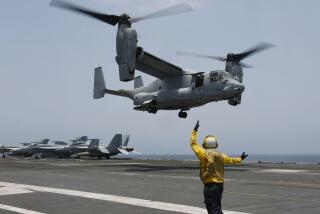Two congressmen seek answers on F-22 fighter jets troubles
- Share via
Recent troubles with the Air Force’s fleet of F-22 Raptor fighter jets have prompted fresh questions by two members of Congress looking for answers on the oxygen problems that have plagued the aircraft for years.
F-22 pilots have reported dozens of incidents in which the jet’s systems weren’t feeding them a proper amount of oxygen in flight, causing hypoxia-like symptoms. Hypoxia is a condition that can cause nausea, headaches, fatigue or even blackouts.
On Tuesday, Rep. Adam Kinzinger (R-Ill.) and Sen. Mark R. Warner (D-Va.) held a teleconference with reporters, saying they wanted more information about three recent incidents.
The most recent was Friday and involved an F-22 pilot at an Air Force base in Hawaii. Before that, an F-22 pilot at a base in Virginia reported a “restricted airflow” incident in late June and an F-22 reportedly hit the runway at a base in Florida without extending its landing gear May 31.
“This seems to be a never-ending saga,” Warner said.
The congressmen want to know whether the new incidents have anything to do with the oxygen issues that led to the grounding of the entire F-22 fleet last year for nearly five months.
The F-22, designed and built by Lockheed Martin Corp., is considered the most advanced fighter jet in the world. It entered service in 2005, and the Air Force received the last of its order of 188 planes this year.
The plane can reach supersonic speeds without using afterburners, enabling it to fly faster and farther. It’s packed with cutting-edge radar and sensors, enabling a pilot to identify, track and shoot an enemy aircraft before that craft can detect the F-22. The Air Force says the aircraft is essential to maintain air dominance around the world.
Since the F-22 grounding was lifted in September, the Air Force said, there have been at least 11 incidents in which F-22 pilots reported hypoxia-like symptoms. The Air Force said investigators could not find a “smoking gun.”
F-22 flights have been restricted by Defense Secretary Leon E. Panetta. Still, Air Force officials maintain that F-22s are safe to fly. In May, the Air Force said that in response to growing concerns about the plan, it had slapped on new safety restrictions to protect its pilots. They include wearing a device that measures the amount of oxygen in the blood, taking blood samples and monitoring pulmonary functions.
Air Force officials believed the problems could be traced to a pressure vest worn by pilots in the cockpit. But Kinzinger, a former Air National Guard pilot, said the new incidents disprove that hypothesis.
“I thought we were onto something,” he said.
In a letter Tuesday to Air Force Secretary Michael B. Donley, Kinzinger and Warner asked pointed questions about the hypoxia-like incidents and the ongoing investigation.
“We would ask that you provide us with a follow-up briefing on these issues within 30 days or sooner so that we might continue to work with you to ensure that the F-22 remains a vital component of the USAF mission,” the letter said.
According to the Air Force, each of the sleek, diamond-winged aircraft costs $143 million. Counting upgrades and research-and-development costs, the U.S. Government Accountability Office estimates that each F-22 costs U.S. taxpayers $412 million.
Although other warplanes in the U.S. arsenal have been used to pummel targets in Iraq, Afghanistan and Libya, the Air Force’s F-22s have sat largely idle — used only in test missions.
F-22s have been involved in seven serious crashes, including two fatalities.
More to Read
Inside the business of entertainment
The Wide Shot brings you news, analysis and insights on everything from streaming wars to production — and what it all means for the future.
You may occasionally receive promotional content from the Los Angeles Times.











